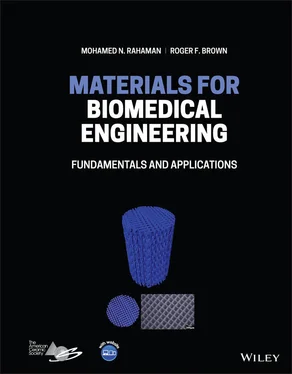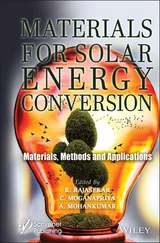5.2.2 Measurement of Contact Angle
While a variety of methods can be used to measure the contact angle of a liquid on a solid (Ratner 2013), the sessile drop technique is easy to perform and, thus, finds considerable use. In this technique, a drop of the appropriate liquid, for example deionized water, is placed on a flat surface of the material according to a standard procedure and the contact angle is determined from images of the drop using automated equipment ( Figure 5.3). The surface tension γ lvof liquids used in contact angle measurements to determine γ cror to estimate γ svof a material ( Eq. (5.6)) can be measured using simple techniques such as capillary rise of a liquid. However, this is often not necessary because the surface tension values of pure liquids at an appropriate experimental temperature such as room temperature are given in reference tables.
For a given liquid, the contact angle and, thus, the wettability of a material depends mainly on its surface chemistry but they can depend on the surface topography as well. Most metals and ceramics are typically more hydrophilic to varying extent due to the lower coordinated bonds at their surface whereas most polymers are more hydrophobic due to their organic surface groups. A rough surface that is wetted without any trapped air between a liquid droplet and the solid ( Figure 5.6), referred to as homogeneous wetting, has an apparent contact angle θ Wgiven by (Marmur 2003):
(5.9) 
where θ is the contact angle for a smooth surface of the same composition and Ρ is the roughness ratio defined as the true area of the rough surface relative to its nominal cross sectional area. In comparison, when wetting of the rough surface is inhomogeneous, that is, when air is trapped between the drop and the rough surface, the apparent contact angle θ CBis given by
(5.10) 
where f is the fraction of the projected area of the solid surface that is wetted by the liquid and Ρ fis the roughness ratio of the wet area. Equations (5.9)and (5.10)are valid when the drop is sufficiently large relative to the roughness scale of the surface. The significance of these equations is that they predict how the roughness of a surface influences its contact angle with a liquid drop.

Figure 5.6 Homogeneous wetting (a) and heterogeneous wetting (b) of a rough surface illustrated for a hydrophobic liquid.
For homogeneous wetting, Eq. (5.9)predicts that a rough surface will decrease the contact angle of a hydrophilic material ( θ < 90°), that is, the hydrophilicity of the material will increase. In comparison, the contact angle of a hydrophobic material ( θ > 90°) will increase with surface roughness, that is, the hydrophobicity of the material will increase. For a greater amount of air trapped between the liquid and the rough surface, f decreases and, consequently, the apparent contact angle is higher. Subsequently, if the liquid slowly infiltrates the areas of trapped air, the contact angle is predicted to decrease with time, eventually becoming smaller than the contact angle of a smooth surface of the same composition. Thus, the measured contact angle of a rough surface can vary, depending on the time.
As an example, Figure 5.7shows the contact angle of deionized water drops on machined surfaces of polyether ether ketone (PEEK) and titanium alloy (Ti6Al4V), and on a microrough surface of silicon nitride (Si 3N 4) in its as‐fabricated state, three biomaterials used in spine repair (Bock et al. 2017). Due to its organic nature, PEEK has the highest contact angle of 86 ± 4°, whereas Ti6Al4V and Si 3N 4, composed of an oxidized surface layer, are more hydrophilic, having a contact angle of 71 ± 5° and 66 ± 9°, respectively. Si 3N 4showed a significant decrease in contact angle to 30 ± 9° after 30 minutes, presumably resulting from the effect of heterogeneous wetting of its microrough surface. The surface of this as‐fabricated Si 3N 4is not composed of pure SiO 2but, instead, a silicon oxynitride composition composed of Si, O, and N atoms. Thermal treatment in an oxidizing atmosphere, in this case seven hours at 1070 °C in air, produced a thicker oxidized layer, the outermost region of which is composed of SiO 2. This resulted in a more hydrophilic surface of contact angle 8 ± 1°.

Figure 5.7 Images showing contact angle of a deionized water drop on (a) machined surface of polyether ether ketone (PEEK), (b) machined surface of Ti6Al4V, (c) surface of as‐fabricated silicon nitride (Si 3N 4), and (d) surface of as‐fabricated Si 3N 4after an oxidation treatment.
Source: From Bock et al. (2017).
5.2.3 Effect of Surface Energy
Apart from its effect in controlling hydrophilicity or hydrophobicity, surface energy by itself has not played a major role in the applications of biomaterials. This is due to a variety of factors. One factor is that the true effect of surface energy is often difficult to separate from contributions from the effects of other surface properties such as surface charge and surface topology. Another factor is the difficulty in correlating surface energy with the interactions of biomaterials with the physiological environment. Often, surface energy is determined from experiments performed under certain ideal conditions that are different from practical conditions in vitro and in vivo . Prior to surface energy measurement, the biomaterial is often subjected to grinding and polishing, and thermal treatment to remove physically and chemically adsorbed water. These treatments can lead to a surface that is different from that of the implanted biomaterial due to adsorption of moisture and impurities such as hydrocarbons from the environment or from the container used for packaging. Standard liquids such as deionized water or, in some cases, phosphate buffered saline used experimentally are also different from the aqueous medium of the physiological environment which contains a variety of ions, small molecules, and proteins.
The surface chemistry of a material influences its behavior in any given environment and, thus, forms the most important surface property of biomaterials. Surface chemistry influences several characteristics of a biomaterial, such as
Chemical reactivity toward its environment as, for example, oxidation in air
Composition of adsorbed ions and molecules
Development of a surface electrostatic charge
Mobility of side groups attached to polymer chains and their structural reorientation at the surface.
Apart from the noble metals such as gold, silver, and platinum, the surface of metals, exposed even for a short time to an environment containing oxygen (such as air) is typically composed of a thin layer of a metal oxide. This is due to the reaction of the surface atoms with chemically adsorbed oxygen molecules, which can be written
Читать дальше
















